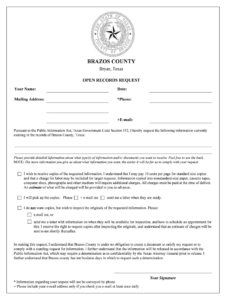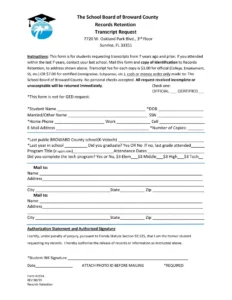Using a standardized form offers several advantages. It increases the likelihood of a successful request by ensuring all necessary components are included. Clear and concise requests reduce processing time, enabling quicker access to the desired information. Further, utilizing a template can help members of the public navigate the sometimes complex process of requesting information, promoting transparency and government accountability.
This article explores the key elements of a successful Illinois FOIA request, offering guidance on completing the required fields and maximizing the effectiveness of such requests. Additional topics covered include understanding common exemptions, navigating potential roadblocks, and available recourse if a request is denied.
Key Components of an Illinois Freedom of Information Act Request
Effective FOIA requests require specific information to ensure clarity and expedite processing. The following components are crucial for submitting a successful request in Illinois.
1. Requester Information: Accurate and complete contact information enables the responding agency to communicate effectively regarding the request status and provide the requested records. This typically includes the requester’s full name, mailing address, phone number, and email address.
2. Agency Identification: Clearly identifying the specific government agency holding the desired records is essential for proper routing and timely processing. Generic requests sent to the wrong agency will likely experience delays.
3. Specific Record Description: A detailed description of the requested records increases the likelihood of a successful retrieval. Vague or overly broad requests can be denied or result in the release of irrelevant information. Specificity helps the agency understand precisely what is being sought.
4. Request Date: Including the date of the request establishes a timeline for the agency to respond within the legally mandated timeframe. This date is crucial for tracking the progress of the request and for any subsequent appeals if necessary.
5. Preferred Format: Specifying the desired format for the records (e.g., electronic, paper copy) helps streamline the delivery process. While not always guaranteed, stating a preference can improve efficiency.
6. Fee Acknowledgement: Acknowledging potential fees associated with copying, redaction, or other processing helps avoid misunderstandings and ensures a smoother process. Some agencies provide fee waivers or reductions under specific circumstances.
7. Signature (when applicable): While not always required for electronic submissions, some agencies may require a physical signature on paper-based requests. Checking specific agency requirements is recommended.
Precise and well-structured requests benefit both the requester and the agency. Complete requests expedite the process, minimize delays, and increase the probability of receiving the desired information promptly and efficiently. These components ensure transparency and promote efficient access to public information.
How to Create an Illinois Freedom of Information Act Request Template
Creating a reusable template for Illinois FOIA requests promotes efficiency and consistency. A well-designed template ensures compliance with statutory requirements and facilitates timely processing by government agencies.
1. Header: Begin with a clear header identifying the document as an “Illinois Freedom of Information Act Request.” This ensures immediate recognition by the receiving agency.
2. Requester Information Section: Designate fields for the requester’s full name, mailing address, phone number, and email address. Clear contact information is essential for correspondence and delivery of requested records.
3. Agency Information Section: Include a section to specify the public body being addressed. This requires fields for the agency’s name, address, and contact information of the FOIA officer, if known.
4. Request Details Section: The core of the template, this section requires a dedicated space for a detailed description of the requested records. Prompts encouraging specificity should be incorporated.
5. Date of Request: Include a field for the date the request is submitted. This establishes the timeframe for the agency’s response and is crucial for tracking purposes.
6. Preferred Format: Provide options for specifying the preferred format for receiving the records (e.g., paper copy, electronic format). This, while not a guarantee, can expedite delivery in the preferred method.
7. Fee Acknowledgement: Include a statement acknowledging potential fees associated with processing the request and options for discussing fee waivers if applicable.
8. Signature Line (Optional): Include a signature line for paper submissions, noting whether a signature is required by the specific agency.
Utilizing a standardized template ensures completeness and reduces the risk of errors or omissions. This structured approach facilitates efficient processing by agencies and increases the likelihood of timely access to requested information, promoting transparency and accountability within Illinois government.
Access to public information is a cornerstone of a transparent and accountable government. Utilizing a well-crafted structure for submitting requests under the Illinois Freedom of Information Act ensures clarity, efficiency, and maximizes the likelihood of successful retrieval of public records. Understanding the key components of a request, including specific record descriptions, accurate contact information, and preferred delivery formats, streamlines the process for both requesters and government agencies. Awareness of potential fees and established timelines further facilitates effective communication and management of expectations throughout the process.
Efficient access to public records empowers citizens, promotes informed decision-making, and strengthens the foundations of democratic governance. Leveraging structured requests contributes to a more transparent and accountable government, fostering public trust and facilitating robust civic engagement. Continued emphasis on clear communication and utilization of established procedures will further refine the process, ensuring open access to information and promoting a more informed populace.


